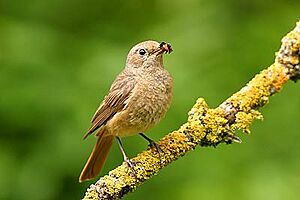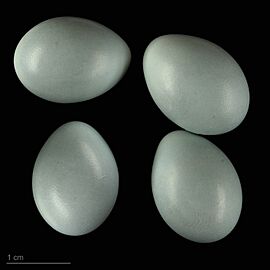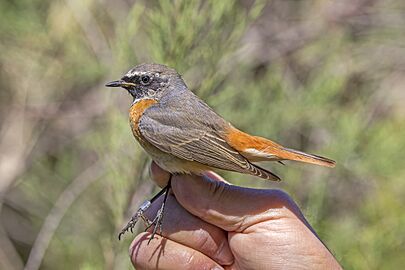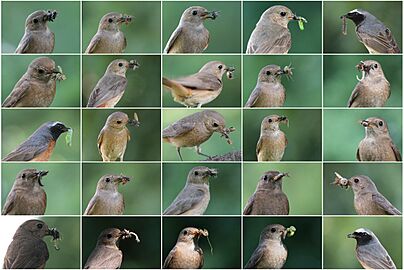Common redstart facts for kids
The common redstart (Phoenicurus phoenicurus) is a small, colorful bird. It's often just called the redstart. This bird belongs to the Old World flycatcher family. It used to be grouped with thrushes, but scientists now know it's part of the flycatcher family.
Quick facts for kids Common redstart |
|
|---|---|
 |
|
| Male |
|
| Conservation status | |
| Scientific classification | |
| Genus: |
Phoenicurus
|
| Species: |
phoenicurus
|
| Subspecies | |
nominate Common Redstart
‘Ehrenberg’s Redstart’ |
|
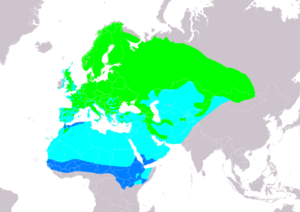 |
|
| Distribution of common redstart Breeding Passage Non-breeding | |
| Synonyms | |
|
Motacilla phoenicurus Linnaeus, 1758 |
|
Contents
What is a Common Redstart?
Naming the Redstart
The common redstart was first officially described in 1758. This was done by a Swedish scientist named Carl Linnaeus. He gave it the scientific name Motacilla phoenicurus. Later, in 1817, another scientist named Thomas Forster created the group Phoenicurus for these birds.
The name phoenicurus comes from ancient Greek words. Phoinix means "red," and -ouros means "tailed." This perfectly describes the bird's bright red tail!
Different Kinds of Redstarts
There are two main types, or subspecies, of the common redstart.
- The first type, P. p. phoenicurus, lives across Europe and into Siberia.
- The second type, P. p. samamisicus, is sometimes called ‘Ehrenberg’s Redstart’. It lives from the Crimean Peninsula through Turkey and into Central Asia.
Adult males of the second type have white patches on their wings. This makes them look a bit different from the first type. These two types often mix in places like the southern Balkans.
What Does a Common Redstart Look Like?
The common redstart is about 13–14.5 cm long. It weighs between 11 and 23 grams. It's similar in size to a European Robin. Its most noticeable feature is its orange-red tail. The bird often wiggles this tail. The word "start" is an old word for "tail," which is how it got its name. Only the Black Redstart has a tail with a similar color in Europe.
Male Redstarts
In summer, male redstarts are very striking. They have a slate-grey head and back. Their rump and tail are bright orange-chestnut. Their forehead is white, and their face and throat are black. The two middle tail feathers are dark brown. The rest of the tail feathers are bright orange-red. Their wings are grey-brown. Some males of the P. p. samamisicus type have white wing patches. Their belly is almost white. Their bill and legs are black. In autumn, their colors look a bit faded because of pale feather edges.
Female Redstarts
Female redstarts are grey-brown on top. Their underside is buff-white or light orange. Most females have a whitish throat. However, some older females might have a dark patch on their throat. This can make them look a bit like the males. Females of the P. p. samamisicus type can also have a light wing patch. This patch is not as bright as the males' patch.
Where Do Common Redstarts Live?
Common redstarts like open woodlands. They prefer areas with birch, oak, or conifer trees. They especially like older trees with holes for nests. They also live in orchards, parks, and old gardens in towns. In Britain, they are found mostly in hilly areas. These areas are not as affected by modern farming.
Redstarts build their nests in holes. These can be natural tree holes. They also use nestboxes that people put up. They like places with lots of moss and lichen.
In England, the number of common redstarts has gone down. It has dropped by 55% in the last 25 years. Because of this, some groups offer help. They provide money to improve woodlands for these birds. In Ireland, they are very rare. Only a few pairs breed there each year.
How Do Common Redstarts Behave?
Migration and Nesting
Common redstarts are summer visitors to Europe and western Asia. They also visit northwest Africa. They spend their winters in central Africa and Arabia. This is south of the Sahara Desert. Males usually arrive in early to mid-April. Females arrive a few days later.
Females lay five or six light blue eggs in May. In warmer areas, they might have a second group of chicks in midsummer. They leave for Africa between mid-August and early October.
What They Eat
Redstarts often catch insects in the air. They fly out to grab passing insects. Most of their food is made up of flying insects.
Their Calls and Songs
The common redstart has different calls. In Central Europe, their main call sounds like a rising "huid." In southern Italy, it's a single "heed" sound. This call can be rising or steady. In Siberia, they might combine these calls. They also make ticking alarm calls.
The male's song is soft and lasts 1-2 seconds. It has three parts: an introduction, a repeated part, and a changing third part. This song structure is quite similar across Europe.
Redstarts and Cuckoos
Sometimes, common cuckoos lay their eggs in redstart nests. This is called brood parasitism. Surprisingly, redstart chicks often do well even with a cuckoo chick in the nest. The cuckoo chick is much bigger. Its size can actually help keep the nest warm. It's like the cuckoo chick is "brooding" the redstart chicks. Also, the redstart chicks might even get more food. This is because the parent redstarts bring more food for the large cuckoo chick.



